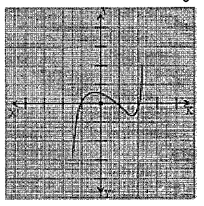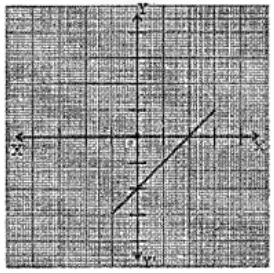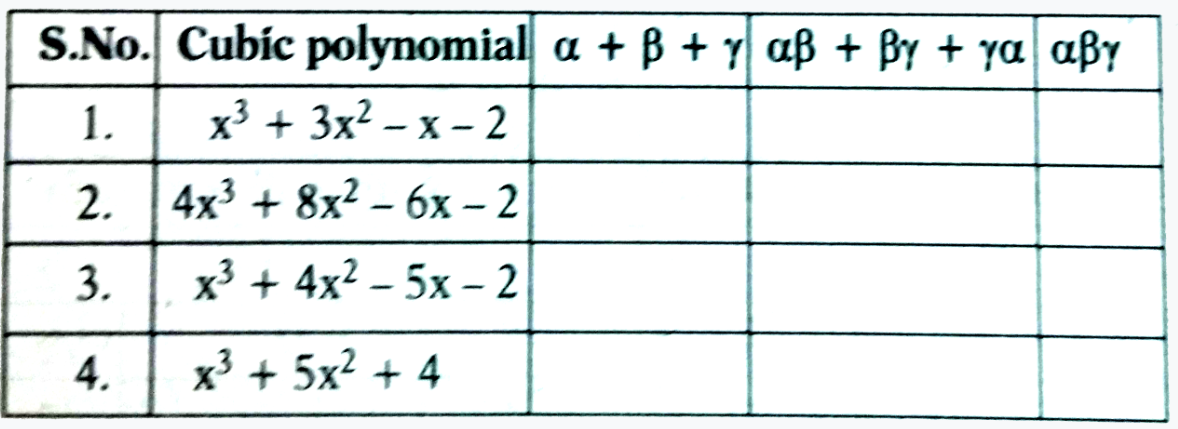Complete Solutions to EXAMPLE of chapter POLYNOMIALS of Class 10 book with complete answers and questions
| Class 10 | MATHS |
| Chapter | POLYNOMIALS |
| BEYOND PUBLICATION | EXAMPLE |
| Number Of Questions | 100 |
| Academic Year | 2023-24 |
State which of the following are polynomial and which are not ? Give resons.
(i) `2x^(3)`
View SolutionState which of the following are polynomial and which are not ? Give resons.
(ii) `1/(x-1)`
View SolutionState which of the following are polynomial and which are not ? Give resons.
(iii) `4z^(2) + 1/7`
View SolutionState which of the following are polynomial and which are not ? Give resons.
(iv) `m^(2)-sqrt(2)m+2`
View SolutionState which of the following are polynomial and which are not ? Give resons.
(v) `p^(-2) + 1`
View SolutionIf `p(x)=x^(2)-5x-6`, then find the values of `p(1),p(2),p(3),p(0),p(-1),p(-2),p(-3)`.
View SolutionIf `p(m)=m^(2)-3m+1`, then find the value of `p(1)` and `p(-1)`.
View SolutionLet `p(x)=x^(2)-4x+3`. Find the value of `p(0),p(1),p(2),p(3)` and obtain zeroes of the polynomial `p(x)`.
View SolutionCheck whether `-3` and 3 are the zeroes of the polynomial `x^(2)-9`.
View SolutionWrite 3 different quadratic, cubic and 2 linear polynomials with different number of terms.
View SolutionWrite a quadratic polynomial and a cubic polynomial in variable x in the general form.
View SolutionWrite a general polynomial q(z) of degree n with coefficients that are `b_(0)….b_(n)`. What are the conditions on `b__(0)……b_(n)`?
View SolutionIf p(x) = `5x^(7)-6 x^(5)+7x-6`, find
(i) coefficient of `x^(5)`
View SolutionIf p(x) = `5x^(7)-6 x^(5)+7x-6`, find
(ii) degree of p(x)
View SolutionIf p(x) = `5x^(7)-6 x^(5)+7x-6`, find
(iii) constant term.
View SolutionState which of the following statements are true and which are false ? Give reasons for your choice.
The degree of the polynomial `sqrt(2)x^(2)-3x+1` is `sqrt(2)`.
View SolutionState which of the following statements are true and which are false ? Give reasons for your choice.
The coefficient of `x^(2)` in the polynomial `p(x)=3x^(3)-4x^(2)+5x+7` is 2
View SolutionState which of the following statements and true and which are false? Give reasons for your choice.
(iii) The degree of a constant term is zero.
View SolutionState which of the following statements and true and which are false? Give reasons for your choice.
(iv) `1/(x^(2)-5x+6)` is a quadratic polynomial.
View SolutionState which of the following statements are true and which are false ? Give reasons for your choice.
The degree of a polynomial is one more than the number of term in it.
View SolutionIf `p(t)=t^(3)-1`, find the values of `p(1),p(-1),p(0),p(2),p(-2)`.
View SolutionCheck whether -2 and 2 are the zeroes of the polynomial `x^(4)-16`.
View SolutionCheck whether 3 and `-2` are the zeroes of the polynomial `p(x)` when `p(x)=x^(2)-x-6`.
View SolutionDraw the graph of (i) y=2x+5 and find the point of intersection on X - axis. Is the x-coordinates of these points also the zero of the polynomial?
View SolutionDraw the graph of (ii) y = 2x - 5 and find the point of intersection on X - axis. Is the x-coordinates of these points also the zero of the polynomial?
View SolutionDraw the graph of (iii) y = 2x and find the point of intersection on X - axis. Is the x-coordinates of these points also the zero of the polynomial?
View SolutionDraw the graph of (i) `y =x^(2) - x - 6` and find zeros in each case. What do you notice?
View SolutionDraw the graph of (ii) `y = 6-x-x^(2)` and find zeros in each case. What do you notice?
View SolutionWrite three quadratic polynomials that have 2 zeroes each.
View SolutionWrite one quadratic polynomial that has one zero.
View SolutionHow will you verify if a quadratic polynomial has only zero ?
View SolutionWrite three qudratic polynomial that have no zeroes for x that are real numbers.
View SolutionFind the zeroes of cubic polynomials
(i) `-x^(3)` without drawing the graph of the polynomial.
View SolutionFind the zeroes of cubic polynomials
(ii) `x^(2) - x^(3)` without drawing the graph of the polynomial.
View SolutionFind the zeroes of cubic polynomials
(iii) `x^(3)-5x^(2)+6x` without drawing the graph of the polynomial.
View SolutionLook at the graph in the figures given below. Each is the graph of y = p(x), where p(x) is a polynomial. In each of the graphs, find the number of zeroes of p(x) in the given range of x.
View SolutionLook at the graphs in the fiures given below. Each is the graph of y = p(x), where p(x) is a polynomial. In each of the graphs, find the number of zeroes of p(x) in the given range of x.

View SolutionLook at the graphs in the fiures given below. Each is the graph of y - p(x), where p(x) is a polynomial. In each of the graphs, find the number of zeroes of p(x) in the given range of x.

View SolutionLook at the graphs in the fiures given below. Each is the graph of y - p(x), where p(x) is a polynomial. In each of the graphs, find the number of zeroes of p(x) in the given range of x.

View SolutionLook at the graph in the figures given below. Each is the graph of y = p(x), where p(x) is a polynomial. In each of the graphs, find the number of zeroes of p(x) in the given range of x.
View SolutionLook at the graph in the figures given below. Each is the graph of y = p(x), where p(x) is a polynomial. In each of the graphs, find the number of zeroes of p(x) in the given range of x.
View SolutionFind the number zeroes of the given polynomials. And also find their values.
`p(x)=2x+1`
View SolutionFind the number of zeroes of the given polyminals. And also find their values.
(ii) `q(y) = y^(2)-1`
View SolutionFind the number zeroes of the given polynomials. And also find their values.
`r(z)=z^(3)`
View SolutionLook at the graph in the figures given below. Each is the graph of y = p(x), where p(x) is a polynomial. In each of the graphs, find the number of zeroes of p(x) in the given range of x.
View SolutionFind the zeroes of the given polynomials.
`p(x)=3x`
View SolutionFind the zeroes of the given polynomials.
`p(x)=x^(2)+5x+6`
View SolutionFind the zeroes of the given polynomials.
`p(x)=(x+2)(x+3)`
View SolutionFind the zeroes of the given polynomials.
`p(x)=x^(4)-16`
View SolutionDraw the graphs of the given polynomial and find the zeroes. Justify the answer.
(i) `p(x) = x^(2) - x - 12`
View SolutionDraw the graphs of the given polynomial and find the zeroes. Justify the answers.
`p(x)=x^(2)-6x+9`
View SolutionDraw the graphs of the given polynomial and find the zeroes. Justify the answer.
(iii) `p(x) =x^(2) - 4x +5`.
View SolutionDraw the graphs of the given polynomial and find the zeroes. Justify the answer.
(iv) `p(x) = x^(2) + 3x -4`
View SolutionDraw the graphs of the given polynomial and find the zeroes. Justify the answer.
(v) `p(x) = x^(2) - 1`.
View SolutionWhy are `1/4` and -1 zeroes of the polynomial `p(x) = 4x^(2) + 3x -1`?
View SolutionFind the zeroes of the quadratic polyno-mials given below. Find the sum and product of the zeroes and verify relationship to the coefficients of terms in the polynomials.
(i) `p(x) = x^(2)-x-6`.
View SolutionFind the zeroes of the quadratic polynomials given below. Find the sum and product of the zeroes and verify relationship to the coeffcients of terms of terms in the polynomial.
`p(x)=x^(2)-4x+3`
View SolutionFind the zeroes of the quadratic polyno-mials given below. Find the sum and product of the zeroes and verify relationship to the coefficients of terms in the polynomials.
(iii) `p(x) = x^(2) - 4`
View SolutionFind the zeroes of the quadratic polyno-mials given below. Find the sum and product of the zeroes and verify relationship to the coefficients of terms in the polynomials.
(iv) `p(x) = x^(2) + 2x +1`.
View SolutionIf `alpha, beta, gamma` are the zeroes of the given cubic polynomials, find the values as given in the table.

View SolutionFind a quadratic polynomial with zeroes -2 and `1/3`.
View SolutionWhat is the quadratic polynomial whose sum of zeroes is `(-3)/2` and the product of zeroes is `-1`.
View SolutionFind the zeroes of the quadratic polynomial `x^(2)+7x+10`, and verify the relationship between the zeroes and the coefficients.
View SolutionFind the zeroes of the polynomial `x^(2)-3` and verify the relationship between the zeroes and the coefficients.
View SolutionFind a quadratic polynomial, the sum and product of whose zeroes are -3 and 2 respectively.
View SolutionFind a quadratic polynomial if the zeroes of it are 2 and `(-1)/3` respectively.
View SolutionVerify that `3, -1, -1/3` are the zeroes of the cubic polynomial `p(x) = 3x^(2)-5x^(2)-11x-3`, and then verify the relationship between the zeroes and the coefficients.
View SolutionFind the zeroes of the following quadratic polynomials and verify relationship between the zeroes and the coefficients.
`x^(2)-2x-8`
View SolutionFind the zeroes of the following quadratic polynomials and verify relationship between the zeroes and the coefficients.
`4s^(2)-4s+1`
View SolutionFind the zeroes of the following quadratic polynomials and verify relationship between the zeroes and the coefficients.
`6x^(2)-3-7x`
View SolutionFind the zeroes of the following quadratic polynomials and verify relationship between the zeroes and the coefficients.
`4u^(2)+8u`
View SolutionFind the zeroes of the following quadratic polynomials and verify relationship between the zeroes and the coefficients.
`t^(2)-15`
View SolutionFind the zeroes of the following quadratic polynomials and verify relationship between the zeroes and the coefficients.
`3x^(2)-x-4`
View SolutionFind the quadratic polynomial in each case, with the given numbers as the sum and product of its zeroes respectively.
`(1)/(4),-1`
View SolutionFind the quadratic polynomial in each case, with the given numbers as the sum and product of its zeroes respectively.
`sqrt(2),1/3`
View SolutionFind the quadratic polynomial in each case, with the given numbers as the sum and product of its zeroes respectively.
`0,sqrt(5)`
View SolutionFind the quadratic polynomial in each case, with the given numbers as the sum and product of its zeroes respectively.
1,1
View SolutionFind the quadratic polynomial in each case, with the given numbers as the sum and product of its zeroes respectively.
`-1/4,1/4`
View SolutionFind the quadratic polynomial in each case, with the given numbers as the sum and product of its zeroes respectively.
4,1
View SolutionFind the quadratic polynomial, for the zeroes `alpha, beta` given in each case.
`2,-1`
View SolutionFind the quadratic polynomial, for the zeroes `alpha, beta` given in each case.
`sqrt(3)-sqrt(3)`
View SolutionFind the quadratic polynomial, for the zeroes `alpha, beta` given in each case.
`1/4, -1`
View SolutionFind the quadratic polynomial, for the zeroes `alpha, beta` given in each case.
`1/2,3/2`
View SolutionVerify that 1, -1 and -3 are the zeroes of the cubic polynimial `x^(3)+3x^(2)-x-3` and check the relationship between zeroes and the coefficients.
View SolutionDivide `2x^(2)+3x+1 by x+2`.
View SolutionDivide `3x^(2)+x^(2)+2x+5`by `1+2x+x^(2)`.
View SolutionDivide `3x^(2)-x^(3)-3x+5` by `x-1-x^(2)`, and verify the division algorithm.
View SolutionFind all the zeroes of `2x^(4)-3x^(3)-3x^(2)+6x-2`, if you know that two of its zeroes are `sqrt(2)` and `-sqrt(2)`.
View SolutionDivide the polynomial `p(x)` by the polynomial `g(x)` and find the quotient and remainder in each of the following :
`p(x)=x^(3)-3x^(2)+5x-3,g(x)=x^(2)-2`
View SolutionDivide the polynomial `p(x)` by the polynomial `g(x)` and find the quotient and remainder in each of the following :
`p(x)=x^(4)-3x^(2)+4x+5,g(x)=x^(2)+1-x`
View SolutionDivide the polynomial `p(x)` by the polynomial `g(x)` and find the quotient and remainder in each of the following :
`p(x)=x^(4)-5x+6,g(x)=2-x^(2)`
View SolutionCheck in which case the first polynomial is a factor of the second polynomial by dividing the second polynomial by the first polynomial :
`t^(2)-3,2t^(4)+3t^(3)-2t^(2)-9t-12`
View SolutionCheck in which case the first polynomial is a factor of the second polynomial by dividing the second polynomial by the first polynomial :
`x^(2)+3x+1 ,3x^(4)+5x^(3)-7x^(2)+2x+2`
View SolutionCheck in which case the first polynomial is a factor of the second polynomial by dividing the second polynomial by the first polynomial :
`x^(3)-3x+1,x^(5)-4x^(3)+x^(2)+3x+1`
View SolutionObtain all other zeroes of `3x^(4)+6x^(3)-2x^(2)-10x-5`, if two of its zeroes are `sqrt(5/3)` and `-sqrt(5/3)`.
View SolutionOn dividing `x^(3)-3x^(2)+x+2` by a polynomial `g(x)` the quotient and remainder were `x-2` and `-2x+4`, respectively. Find `g(x)`.
View SolutionGive example of polynomials p(x), g(x), q(x) and r(x), which satisfy the division algorithm and
(i) deg p(x) = deg q(x).
View SolutionGive example of polynomials p(x), g(x), q(x) and r(x), which satisfy the division algorithm and
(ii) deg q(x) = deg r(x).
View SolutionGive example of polynomials p(x), g(x), q(x) and r(x), which satisfy the division algorithm and
(i) deg p(x) = deg q(x).
View SolutionVerify that the numbers given along side the cubic polynomials below are their zeroes. Also verify the relationship between the zeroes and the coefficients in each case.
(i) `2x^(3) + x^(2) - 5x +2 , (1/2, 1, -2)`
View Solution
EXAMPLE questions and complete solutions for chapter POLYNOMIALS of BEYOND PUBLICATION of Class 10